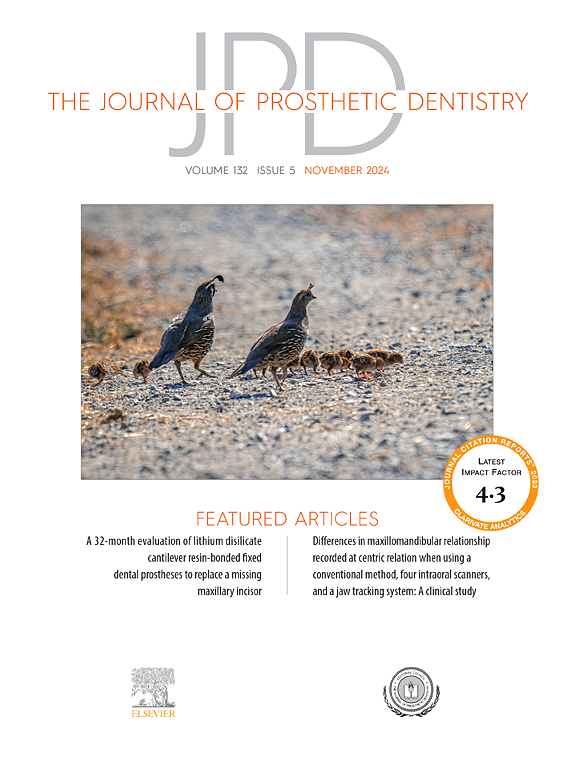采用不同口腔内扫描方案制作的多单元种植体支持前牙固定修复体的内部和边缘配合度的三维评价:一项体外研究。
IF 4.8
2区 医学
Q1 DENTISTRY, ORAL SURGERY & MEDICINE
引用次数: 0
摘要
问题陈述:口腔内扫描仪的快速发展和牙种植体扫描体的广泛采用简化了种植体位置数据的数字化采集和随后种植体支持的假体的制造。然而,关于多单元种植体支撑固定义齿(fdp)的无铸造工艺的配合研究较少。目的:本研究的目的是通过不同的口腔内扫描方案和数字数据叠加和分析技术来评估氧化锆制备的6单元种植体支持fdp的内部和边缘拟合。材料和方法:制作确定型模型,在上颌右尖牙、右中切牙和左尖牙位置放置种植体,模拟6颗上颌前牙的部分全牙化。将种植体扫描体附着在种植体上,连续进行10次口腔内扫描。根据其中一个扫描数据集设计定制基台,并在单步无铸造工作流程中制作6个氧化锆假体(n=10)(组IL)。然后制作设计的定制基台并拧紧到最终铸件上,随后进行另外一组10次口内扫描以制作另一组6单元氧化锆假体(AL组;n = 10)。使用立方体嵌入种植体扫描体库和定制基台数据集对口腔内扫描数据进行分析。测量口腔内扫描数据中每个立方体之间的距离,并计算它们相对于桌面扫描数据获得的比率。此外,测量种植体的角度,并计算种植体对之间的角度差异。将制造的假体安装到最终铸件上,并使用三维数据叠加技术评估内部和边缘间隙。采用方差检验的2-way分析(α= 0.05)。结果:IL组与AL组的距离比明显接近参考值(p < 0.05)。结论:通过单步、无铸造流程制作的氧化锆假体比通过两步工艺制作的假体具有更小的内部间隙。然而,两种扫描方案之间的氧化锆假体的边缘拟合没有显著差异。本文章由计算机程序翻译,如有差异,请以英文原文为准。
Three-dimensional evaluation of the internal and marginal fit of multiunit implant-supported anterior fixed dental prostheses fabricated using different intraoral scanning protocols: An in vitro study
Statement of problem
The rapid advancement of intraoral scanners and the widespread adoption of dental implant scan bodies have streamlined the digital acquisition of implant position data and the subsequent fabrication of implant-supported prostheses. However, research on the fit of multiunit implant-supported fixed dental prostheses (FDPs) fabricated using a cast-free workflow is sparse.
Purpose
The purpose of this study was to evaluate the internal and marginal fit of 6-unit implant-supported FDPs fabricated from zirconia by using different intraoral scanning protocols and digital data superimposition and analysis techniques.
Material and methods
A definitive cast with implants placed in the maxillary right canine, right central incisor, and left canine positions was fabricated to simulate the partial edentulism of the 6 maxillary anterior teeth. Implant scan bodies were attached to the implants, and 10 consecutive intraoral scans were made. Custom abutments were designed based on one of the scan datasets, and 6-unit zirconia prostheses (n=10) were fabricated in a single-step cast-free workflow (Group IL). The designed custom abutments were then fabricated and tightened onto the definitive cast, followed by an additional set of 10 intraoral scans to fabricate another set of 6-unit zirconia prostheses (Group AL; n=10). The intraoral scan data were analyzed by using a cube-embedded implant scan body library and custom abutment dataset. Distances between each cube in the intraoral scan data were measured, and their ratios calculated relative to those obtained from tabletop scan data. Additionally, implant angulation was measured, and angular discrepancies between implant pairs were calculated. The fabricated prostheses were fitted onto the definitive cast, and internal and marginal gaps were assessed by using 3-dimensional data superimposition techniques. The data were analyzed by using a 2-way analysis of variance test (α=.05).
Results
The distance ratio in Group IL was significantly closer to the reference value than that in Group AL (P<.001). The angular discrepancy between implant positions was significantly smaller in Group IL than in Group AL (P<.001). The mean internal gap in Group AL was significantly greater than that in Group IL (P=.007). However, no significant difference was observed between the groups when comparing the marginal gaps of the zirconia prostheses (P>.05).
Conclusions
Zirconia prostheses fabricated through a single-step, cast-free workflow exhibited significantly smaller internal gaps than those fabricated through a 2-step process. However, the marginal fit of the zirconia prostheses did not significantly differ between the 2 scanning protocols.
求助全文
通过发布文献求助,成功后即可免费获取论文全文。
去求助
来源期刊

Journal of Prosthetic Dentistry
医学-牙科与口腔外科
CiteScore
7.00
自引率
13.00%
发文量
599
审稿时长
69 days
期刊介绍:
The Journal of Prosthetic Dentistry is the leading professional journal devoted exclusively to prosthetic and restorative dentistry. The Journal is the official publication for 24 leading U.S. international prosthodontic organizations. The monthly publication features timely, original peer-reviewed articles on the newest techniques, dental materials, and research findings. The Journal serves prosthodontists and dentists in advanced practice, and features color photos that illustrate many step-by-step procedures. The Journal of Prosthetic Dentistry is included in Index Medicus and CINAHL.
 求助内容:
求助内容: 应助结果提醒方式:
应助结果提醒方式:


